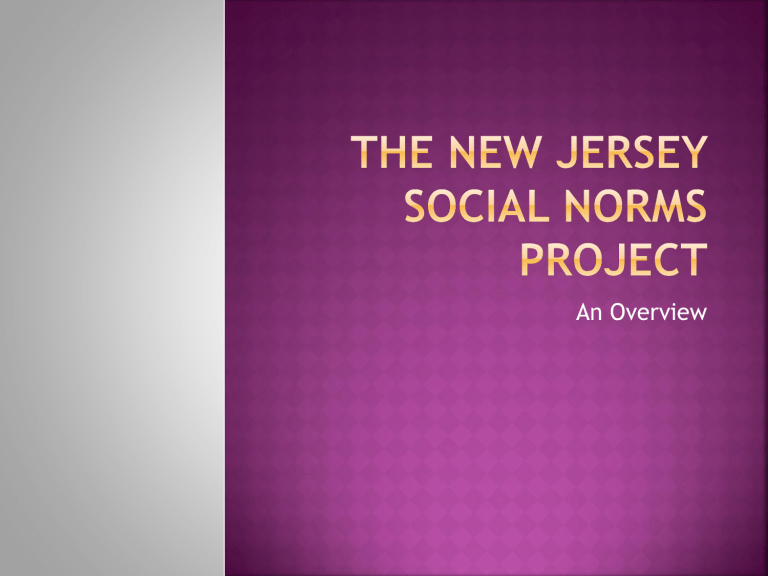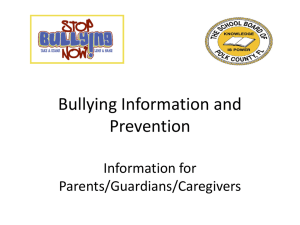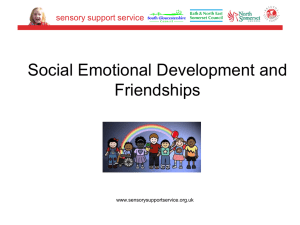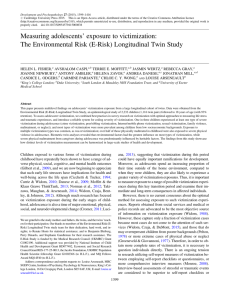The New Jersey Social Norms Project: An Overview

An Overview
Youth Experiences Matter!
School staff are faced with a multitude of student issues
Students who are struggling with other problems have difficulty succeeding in the classroom
Key Examples of Student Problems:
Alcohol, tobacco and other drug (ATOD) use
ATOD use negatively affects student performance and health outcomes
Bullying and Victimization
Students who fear for their safety risk decreased performance and long-term mental health issues
Students who bully disrupt the learning process and negatively affect the school culture and climate
Social Norms Campaigns!
Promote positive student behavior by reinforcing prosocial actions
Help students realize that most of their peers are not participating in high-risk behaviors
Evidence-Based Practices
Environmental design, school-based prevention efforts have some of the most positive effects on student behavior (Gottfredson, Wilson, and Najaka 2001)
Four years of New Jersey Social Norms Project evaluation show positive results
29 High Schools
36 Middle Schools
New Jersey Middle Schools
All regions – north, south, and central
All settings – rural, urban, and suburban
Reduce bullying and victimization behavior
Correct student and community misperceptions of peers’ behavior
Most students are engaging in positive behavior!
New Jersey High Schools
All regions – north, south, and central
All settings – rural, urban, and suburban
Reduce alcohol, tobacco, and other drug (ATOD) use
Correct student and community misperceptions of peers’ ATOD use
Everyone isn’t drinking! Everyone isn’t drugging!
Everyone isn’t smoking!
Annual Survey
Quantified the perceptions and behavior in each school
Personalized the information for students in each school
Highlight Positive Behaviors
Statistics were chosen that best addressed the issues in each school
Marketing Campaign
Created messages based on the survey statistics to promote the priority positive behavior in each school
Used a variety of strategies to promote the messages
Community Resources
Promoted positive behavior beyond the school property
Coordinated with businesses to create incentives for students
Composed of members of the school community who directed each school’s campaign
Members included
School staff (e.g., school counselors, student assistance coordinators, administrators, teachers, Child Study Team members, supervisors of curriculum and instruction)
Parents
Community members (e.g., Municipal Alliance Committee members, local business owners)
Students
Duties included
Planning and administering surveys
Planning campaign activities
Developing social norms Message
Communicating with school staff, parents and local community members
Sent a letter describing the project
Used the beginning of school-year activities, such as
“Back to School Night,” to promote the project
Obtained parental consent for surveying
(Two weeks prior to the survey is a good window of time)
Shared the results of the surveys
Informed parents of how great their kids were doing
Used school mailings, emails, and special events to communicate the information to parents
Kept them informed on an ongoing basis
Encouraged parents to discuss results at home with their children
Used school-based methods of information delivery
(e.g., Web sites, newsletters) to continue to promote the project
Promoted activities through local news sources
Websites
Newspapers
Other print media
Radio
Hung school messages on posters in local businesses
Encouraged collaboration
Coordinated with local businesses to promote their services on campaign materials in return for support
Provided free gift certificates for schools to use as incentives
Special discounts for students who knew the school’s messages
Hung posters around school
Chose high traffic locations
Changed posters occasionally for variety
More strategies = better outcomes (creativity)
Used a variety of methods for delivering messages
Posters
Games
Assemblies
Announcements
Newsletters
Screensavers
Included faculty in discussions
Used faculty meetings as a vehicle for disseminating classroom strategies and promoting messages
Continued discussions informally
Encouraged the school staff to promote the messages whenever the opportunity arose
A variety of constructs measured change
Behavioral measures
Victimization
Physical, property, and emotional
Bullying
Perceptual measures
Amount of peer victimization
Amount of peer bullying
Other measures
Avoidance Tactics
Telling Adults
Analytic Technique
Independent samples z-tests for proportions with separate variances
Overall Findings
Basic Trends
Students overestimated peers’ behavior
Emotional bullying was highest for boys and girls
Boys were more likely to be involved in physical bullying and victimization
Girls were more likely to be involved in cyber-bullying and victimization
Students were willing to tell an adult about bad behavior
Common school areas (e.g., cafeteria, hallways, bathrooms) are the places that students were most likely victimized
Changes in Behavior
All types of victimization were reduced after implementation of the social norms campaign
Self-reported bullying decreased in three areas: overall, physical and emotional
Property bullying was possibly a separate issue
Actual Victimization
Ever Been Bullied**
Report Any Victimization*
Physical Victimization***
Property Victimization***
Emotional Victimization***
Time 1
N = 1060
%
66.0
80.8
45.3
30.6
75.2
Time 2
N = 961
%
54.3
76.4
36.4
43.0
67.0
± p<.10; *p<.05; **p<.01; **p<.001
Note: P-values represent levels of statistical significance; lower p-values indicate higher levels of significance.
Statistically significant data is italicized on results slides.
Measurement changes between Time 1 and Time 2 may account for the increases in reported physical bullying.
Perceptions of Victimization
Report Any Victimization**
Physical Victimization***
Property Victimization*
Emotional Victimization**
± p<.10; *p<.05; **p<.01; ***p<.001
Time 1
N=1060
%
93.9
79.6
63.3
92.5
Time 2
N=961
%
88.8
57.1
56.0
83.8
Actual Bullying
Report Any Bullying*
Physical Bullying**
Property Bullying
Emotional Bullying**
± p<.10; *p<.05; **p<.01; **p<.001
Time 1
N=1060
%
61.0
32.2
11.1
54.0
Time 2
N=961
%
55.2
44.8
10.2
34.0
Measurement changes between Time 1 and Time 2 may account for the increases in reported physical bullying.
Perceptions of Peer Bullying
Report Any Bullying**
Physical Bullying*
Property Bullying
Emotional Bullying***
± p<.10; *p<.05; **p<.01; ***p<.001
Time 1
N=1060
%
90.6
76.9
37.3
88.6
Time 2
N=961
%
82.8
71.6
38.3
69.9
Avoidance Tactics
Hallway
Bathroom
Cafeteria
Other School Places
Avoid Any Space
Skip Class or School
± p<.10; *p<.05; **p<.01; ***p<.001
Time 1
N=1060
9.9
5.5
1.4
16.9
11.9
30.1
Time 2
N=961
12.6
13.6
13.9
16.1
10.1
35.7
Telling an Adult
Tell if being bullied…
Principal**
Teacher/Counselor
Police***
Parent ±
Friend**
Any Adult*
Tell if see weapon…
Principal
Teacher/Counselor**
Police**
Parent**
Friend***
Any Adult**
± p<.10; *p<.05; **p<.01; ***p<.001
Time 1
N=1060
%
86.7
76.7
71.6
66.6
41.7
96.5
Time 1
N=1060
%
64.4
81.0
24.5
71.9
53.0
92.5
Time 2
N=961
%
86.5
85.3
80.2
80.1
68.7
92.9
Time 2
N=961
%
72.9
82.9
43.8
75.4
69.5
89.1
A variety of constructs were used to measure change
Behavioral measures
ATOD use
Perceptual measures
Amount of peer ATOD use
Other measures
Negative consequences of ATOD use
Resistance skills
Telling adults
Analytic Technique
Independent samples z-tests for proportions with separate variances
Overall Trends
Differences in survey between Time 1 and Time 2
Suggests that increases in the targeted behaviors had to be examined cautiously
Harm Reduction
Negative consequences of alcohol use significantly decreased between time periods
Resistance Skills
Students reported being more likely to resist using alcohol and tobacco when offered, after the campaign
Changes in Behavior
Alcohol use and perceptions of use decreased
Telling an Adult
Students showed some resistance
Most likely because students did not understand the benefit of adult notification and intervention
ATOD Use – last 30 days
Last 30 Days…
Tobacco*
Alcohol**
Marijuana**
Other Illicit Drugs**
± p<.10; *p<.05; **p<.01; ***p<.001
Time 1
N=2254
%
11.7
44.6
9.0
5.7
Time 2
N=1732
%
14.2
35.8
16.6
14.1
Measurement changes between Time 1 and Time 2 may be driving the increase in reporting of illicit drugs.
Perceptions of Peers’ ATOD Use
How many do NOT use…
Tobacco*
Alcohol**
Marijuana**
Other Illicit Drugs
Time 1 Time 2
Students in grade… People your age…
N=2254
%
N=1732
%
6.3
3.6
12.1
22.5
4.7
5.6
8.2
20.7
± p<.10; *p<.05; **p<.01; ***p<.001
Measurement changes between Time 1 and Time 2 may explain differences in reporting of peer perceptions.
Negative Consequences
Resistance Skills
Saying no to…
Cigarettes**
Alcohol**
± p<.10; *p<.05; **p<.01; ***p<.001
Time 1 Time 2
N=2254 N=1732
Time 1 Time 2
74.6
63.4
83.4
71.3
Telling an Adult
Tell an adult about drugs…
Principal**
Teacher or Counselor**
Police Officer**
Parent or Adult Family Member**
Friend***
Any Adult**
± p<.10; *p<.05; **p<.01; ***p<.001
Time 1 Time 2
N=2254 N=1732
%
39.2
%
25.4
52.4
34.2
35.2
40.8
62.3
38.0
27.9
50.9
83.0
57.0
Support for change
Both bullying behavior and ATOD use changed for the better using the social norms campaign
Perceptions and behavior both changed in desired direction
Students paid attention
Social norms campaigns helped change student beliefs and encouraged continued positive behavior
Variety was the key!
The more ways the messages were presented, the more likely the students listened
Social events matter
Students can be sensitized to issues when they are regularly portrayed in the media, which can affect survey data
High schools – marijuana
Middle-schools – cyber-bullying
Marketing campaign may increase awareness
Previous social norms campaigns focus only on ONE behavior – the campaigns under the New Jersey project focused on several kinds of behaviors
It is possible that students will initially perceive an increase in a behavior BECAUSE it is being brought to their attention, not because it actually has increased
Decrease in actual behaviors, however, suggests students began to internalize the messages






